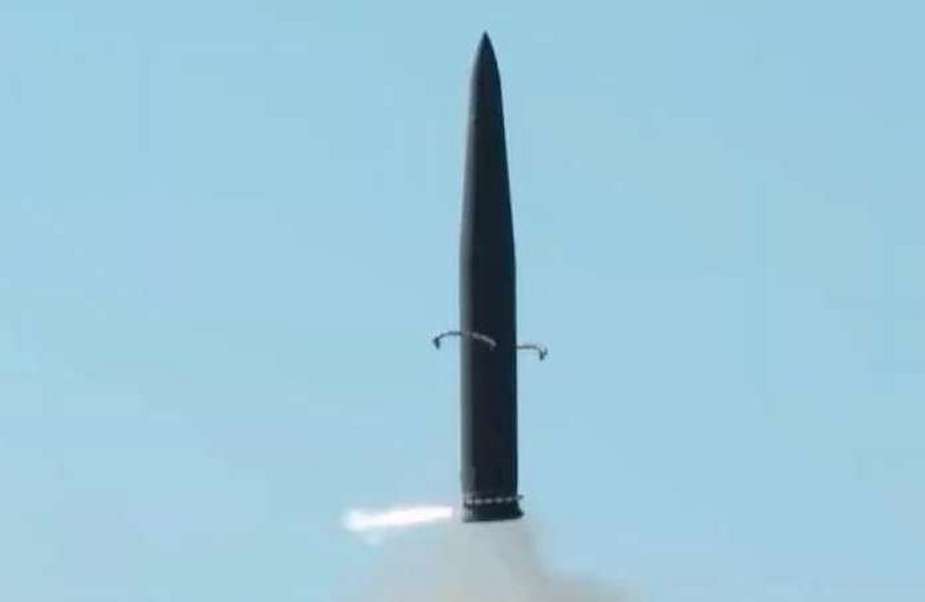Breaking news
South Korea to invest $218 Mn in improvement of Hyunmoo-5 bunker buster missile.
South Korea is planning a substantial investment of approximately 290 billion won ($218 million) for the development of the Hyunmoo-5, an advanced iteration of a domestically produced bunker-penetrating missile. This missile is intended for striking concealed subterranean enemy targets, as revealed by the nation's state arms procurement agency on September 18, echoed by the Korea Times. The endeavor is a response to South Korea's military's commitment to bolstering its deterrent capabilities in the face of the evolving missile and nuclear threats posed by North Korea.
Follow Army Recognition on Google News at this link

Hyunmoo-5 tactical ballistic "bunker buster" missile (Picture source: South Korean MoD)
The enhanced South Korean short-range tactical surface-to-surface missile, known as the Hyunmoo-5, represents a significant advancement in South Korea's military capabilities, particularly in precision strikes against concealed tunnel and bunker-based targets. This formidable weapon will be deployed on a mobile launcher, bolstering the country's ability to neutralize subterranean North Korean weapon systems, including long-range artillery pieces hidden within tunnels. The missile is designed with a penetrator warhead weighing approximately 2.5 to 3 tons, ensuring its effectiveness against fortified underground targets.
According to information from globalsecurity.org, the Hyunmoo-5 has earned the nickname "monster missile" due to its exceptional capabilities. While the previously mentioned 8-9 ton warhead weight may contain a typographical error, it is clear that this missile has a substantial payload capacity. Additionally, the Hyunmoo-5 boasts incredible speed, descending upon its target at speeds 10 times faster than the speed of sound. With a thrust of 75 tons, it has the potential to carry one of the world's largest warheads, making it capable of causing significant damage to deeply buried tunnels and bunkers, potentially mimicking the effects of nuclear weapons.
Although the exact maximum range of the Hyunmoo-5 remains undisclosed, experts speculate it could potentially reach distances of up to 3,000 kilometers or even farther, placing it in the category of intermediate-range missiles. Once deployed, the Hyunmoo-5 is expected to play a central role in South Korea's Korea Massive Punishment and Retaliation (KMPR) operational plan, designed to incapacitate North Korean leadership in the event of a major conflict. This missile is a crucial component of South Korea's three-axis defense system aimed at countering North Korea's nuclear and missile development efforts.
Analysts suggest that the Hyunmoo-5's versatility allows it to carry a conventional warhead of up to 9 tons, which, when paired with its substantial range, could theoretically pose a threat to neighboring countries like China. This capability underscores its importance in responding to regional security concerns.
It's worth noting that the Hyunmoo-5's specifications, including its warhead weight and thrust, make it similar to the U.S. Minuteman 3 intercontinental ballistic missile (ICBM), although the Hyunmoo-5 is believed to be a two-stage ICBM and may have multiple independently targetable reentry vehicles (MIRV).
The primary objective of the Hyunmoo-5 is presumed to be the destruction of North Korea's nuclear facilities, given its substantial warhead weight and range, making it a formidable weapon in this regard. Its ability to penetrate deep underground targets and cause substantial structural damage could significantly impact North Korea's nuclear infrastructure.
With the development of the Hyunmoo-5, South Korea joins the ranks of countries in Northeast Asia with IRBMs or comparable capabilities, further enhancing its ability to respond to regional threats. This missile's development has been a multi-year effort, with anticipated mass production slated to begin by the conclusion of 2023. Oversight for this ambitious project falls under the state-affiliated Agency for Defense Development, with various defense corporations participating in the production of prototype models. This comprehensive initiative is expected to continue through 2027.
Defense News September 2023


























